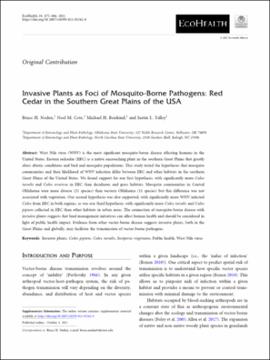| dc.contributor.author | Noden, Bruce H. | |
| dc.contributor.author | Cote, Noel M. | |
| dc.contributor.author | Reiskind, Michael H. | |
| dc.contributor.author | Talley, Justin L. | |
| dc.date.accessioned | 2022-04-12T13:47:54Z | |
| dc.date.available | 2022-04-12T13:47:54Z | |
| dc.date.issued | 2021-10-05 | |
| dc.identifier | oksd_noden_invasiveplantsasfoci_2021 | |
| dc.identifier.citation | Noden, B. H., Cote, N. M., Reiskind, M. H., & Talley, J. L. (2021). Invasive plants as foci of mosquito-borne pathogens: Red cedar in the southern Great Plains of the USA. EcoHealth, 18(4), pp. 475-486. https://doi.org/10.1007/s10393-021-01562-8 | |
| dc.identifier.uri | https://hdl.handle.net/11244/335163 | |
| dc.description.abstract | West Nile virus (WNV) is the most significant mosquito-borne disease affecting humans in the United States. Eastern redcedar (ERC) is a native encroaching plant in the southern Great Plains that greatly alters abiotic conditions and bird and mosquito populations. This study tested the hypotheses that mosquito communities and their likelihood of WNV infection differ between ERC and other habitats in the southern Great Plains of the United States. We found support for our first hypothesis, with significantly more Culex tarsalis and Culex erraticus in ERC than deciduous and grass habitats. Mosquito communities in Central Oklahoma were more diverse (21 species) than western Oklahoma (11 species) but this difference was not associated with vegetation. Our second hypothesis was also supported, with significantly more WNV-infected Culex from ERC in both regions, as was our third hypothesis, with significantly more Culex tarsalis and Culex pipiens collected in ERC than other habitats in urban areas. The connection of mosquito-borne disease with invasive plants suggests that land management initiatives can affect human health and should be considered in light of public health impact. Evidence from other vector-borne disease suggests invasive plants, both in the Great Plains and globally, may facilitate the transmission of vector-borne pathogens. | |
| dc.format | application/pdf | |
| dc.language | en_US | |
| dc.publisher | Springer Science and Business Media LLC | |
| dc.relation.ispartof | EcoHealth, 18 (4) | |
| dc.relation.uri | https://www.ncbi.nlm.nih.gov/pubmed/34613506 | |
| dc.rights | This material has been previously published. In the Oklahoma State University Library's institutional repository this version is made available through the open access principles and the terms of agreement/consent between the author(s) and the publisher. The permission policy on the use, reproduction or distribution of the material falls under fair use for educational, scholarship, and research purposes. Contact Digital Resources and Discovery Services at lib-dls@okstate.edu or 405-744-9161 for further information. | |
| dc.subject.mesh | Animals | |
| dc.subject.mesh | Culex | |
| dc.subject.mesh | Culicidae | |
| dc.subject.mesh | Humans | |
| dc.subject.mesh | Mosquito Vectors | |
| dc.subject.mesh | United States | |
| dc.subject.mesh | West Nile Fever | |
| dc.subject.mesh | West Nile virus | |
| dc.title | Invasive plants as foci of mosquito-borne pathogens: Red cedar in the southern Great Plains of the USA | |
| dc.date.updated | 2022-04-07T14:03:20Z | |
| osu.filename | oksd_noden_invasiveplantsasfoci_2021.pdf | |
| dc.description.peerreview | Peer reviewed | |
| dc.identifier.doi | 10.1007/s10393-021-01562-8 | |
| dc.description.department | Entomology and Plant Pathology | |
| dc.type.genre | Article | |
| dc.type.material | Text | |
| dc.subject.keywords | Culex pipiens | |
| dc.subject.keywords | Culex tarsalis | |
| dc.subject.keywords | Invasive plants | |
| dc.subject.keywords | Juniperus virginiana | |
| dc.subject.keywords | Public health | |
| dc.subject.keywords | West Nile virus | |
| dc.subject.keywords | Rare Diseases | |
| dc.subject.keywords | Vaccine Related | |
| dc.subject.keywords | Vector-Borne Diseases | |
| dc.subject.keywords | Emerging Infectious Diseases | |
| dc.subject.keywords | Infectious Diseases | |
| dc.subject.keywords | Infection | |
| dc.subject.keywords | 3 Good Health and Well Being | |
| dc.subject.keywords | 0602 Ecology | |
| dc.subject.keywords | 0707 Veterinary Sciences | |
| dc.subject.keywords | 1117 Public Health and Health Services | |
| dc.subject.keywords | Ecology | |
| dc.identifier.author | ORCID: 0000-0002-0096-370X (Noden, BH) | |
| dc.identifier.author | ScopusID: 6601968347 (Noden, BH) | |
| dc.identifier.author | ORCID: 0000-0002-2932-1866 (Talley, JL) | |
| dc.identifier.author | ScopusID: 55168292000 (Talley, JL) | |
